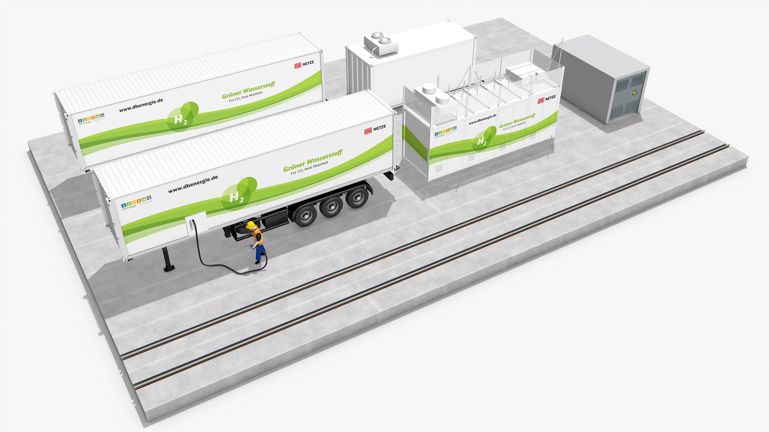 Tell us more about DB’s hydrogen refueling system being developed for the rail sector?
Tell us more about DB’s hydrogen refueling system being developed for the rail sector?
The filling station is part of an entire H2-rail system consisting of train, hydrogen infrastructure and workshop infrastructure that DB is developing in cooperation with Siemens Mobility with the H2goesRail project. DB will amongst others ensure the supply of hydrogen for the project, from production by means of renewable-powered electrolysis all the way through to storage and provision. DB will develop an innovative mobile refueling station whose smart communication interface allows fast fill refueling of hydrogen trains in times comparable to diesel trains. Onsite production of green hydrogen instead of shipment by diesel truck will ensure a fully climate neutral system. The project is funded by the German Ministry of Transport.
Who is DB working with on this part of the project?
The industrial partners for the refueling station are Wenger Engineering and Wystrach: DB and Wystrach are working closely together to develop the refueling system, which will consist of a 45ft tank container and a 40ft refueling station. Wystrach is a supplier of hydrogen technology systems and manufacturer of DB mobile hydrogen refueling station. Wenger Engineering is supporting DB in developing the fast fill refueling process and the innovative communication concept.
Where will the filling station be located? Will there be more than one station?
The entire system will be integrated and used by DB at the existing depot infrastructure located in Tübingen/Ulm in scheduled operation with passengers from 2024 for a one-year period. The filling station will then be located at DB site Tübingen. Hydrogen and the project H2goesRail are playing a major role at DB achieving climate-neutral status and a fully green DB fleet until 2040. To introduce hydrogen solutions for larger fleets in Germany further infrastructure capacity is key.
What stage is the refueling system project at currently?
The project is progressing according to plan. DB is currently finalizing the design phase including interactions between main elements electrolyzer, storage trailer, filling station. In addition, the newly developed hydrogen infrastructure is to be harmonized to existing interfaces of energy supply backend to make hydrogen accessible to customers using similar processes used in today’s conventional fuel supply. Necessary permitting processes are important next steps along with the production and commissioning process to set the base for the first fast fill of a H2 train next year.
How will the system be tested?
In cooperation with partners, DB defines various test cases to proof and ensure a safe and fast-fill refueling at all conditions. The focus is on an innovative communication concept and an energy, time, and cost-efficient refueling process. Additional testing furthermore concentrates on user friendly operation.
What are its key features?
The infrastructure solution developed by DB consists of three main elements:
Green hydrogen production and storage: Green hydrogen production onsite by means of electrolysis using 100% DB green energy. A grid connection system to the overhead line is securing power supply for the electrolyzer and refueling station. An electrolyzer produces hydrogen by separating water in hydrogen and oxygen. Produced hydrogen is compressed to 300 bar in the H2 compressor unit and stored with a capacity of up to 800 kg hydrogen.
Fast refueling: The refueling trailer prepares, cools, and provides hydrogen for refueling of H2 trains. The innovative and intelligent communication interface of the refueling trailer enables fast refueling of H2 vehicles in times comparable to diesel trains. Pressure-regulated refueling control through communication between the train and infrastructure reduces energy consumption and refueling time.
Mobile structure of the system: On the one hand the mobile structure of the refueling and storage trailer is designed to easily be loaded and shipped and enables the future use as an innovative fast refueling station for further test projects and on the other hand all the main design elements and interfaces are scalable for larger, permanently installed systems.

Did DB use expertise from any other industries to develop this solution?
The mobile hydrogen filling station is based on an existing solution for the refueling of fuel cell trucks. The solution has been further developed so that the current system can be used to store and refuel significantly larger quantities of gaseous hydrogen.
What were some of the key challenges associated with developing a hydrogen refueling system for rail?
The rail sector requires a scaling of existing first approaches in terms of the hydrogen supply and refueling infrastructure. Compared to private transport many times higher fueling quantities require an intelligent cooling concept to be able to refuel rail vehicles as quickly as possible. The hydrogen refueling system needs to ensure a well-managed interaction between train and infrastructure.
Actual operation conditions of the vehicle tank system and the temperature ambient conditions are decisive for the actual cooling requirement. Necessary cooling of hydrogen will be adjusted with the development and introduction of a communication interface with associated temperature and pressure-controlled refueling protocol. Thus, a reduction in energy demand for cooling can be achieved for the refueling process.
Besides the gas technology development, the safety requirements expected in the rail sector are a key challenge. To accommodate all this in a mobile refueling station while achieving a fast-refueling time took a lot of development time for DB.
The entire infrastructure is becoming more complex. Instead of a diesel pump and tank, compressors and gas storage tanks are elementary components of a hydrogen filling station, which can also have considerable influence on the refueling time when correctly dimensioned. This is less decisive for today's diesel filling station where only the pump capacity matters. In addition, we have even greater safety requirements, such as start-up protection, protective distances, etc.
How was safety ensured?
Safety of the system is ensured by a two-level approach with an overall permission plus a site-specific operating permission: For the overall permission the mobile tank facility itself must undergo a safety and hazard analysis. However, operation of hydrogen refueling stations always requires a separate site-specific operating permit based on an overall permission to consider site-specific aspects and compliance. This process is accompanied by a request for safety-relevant expert opinions from the approval authority, which relates to the site permission. The procedure is completed by expert support during the commissioning process. These requirements and the training of our own employees create the basis for safe plant operation.
Can existing refueling facilities be retrofitted with hydrogen systems, or do they need to be developed from scratch?
Due to the complexity of the technology and fulfilment of dedicated safety requirements existing diesel refueling stations for rail vehicles itself cannot be converted to refueling with gaseous hydrogen. Nevertheless, the established and well-accessible locations of current refueling facilities within the railway network could be reused.
What key advice would you give to other rail operators looking to develop a hydrogen refueling infrastructure?
The introduction of the hydrogen fuel cell technology can only be achieved if the technology is implemented as a whole ecosystem (vehicle / infrastructure) and developed and aligned in a coordinated manner.
Fast refueling through communication of data between the train and infrastructure, such as the actual operation conditions of the vehicle tank system and the temperature ambient conditions, is a key element to reach refueling times compared to existing diesel multiple units. H2 trains must be “ready for fast refueling” by means of safe communication of all relevant data to the infrastructure and design of the vehicles tank system.
Hydrogen offers the potential to link different sectors and open new applications in the context of the energy transition. For example, a hydrogen filling station can be used to supply commercial vehicles as well as rail vehicles. In addition, with the storage of hydrogen, for example, the increasing proportion of fluctuating renewable energies can be countered.
What is the aim of this project?
The aim of the project is to review the suitability for everyday use and readiness of the developed H2-rail system in scheduled operations for a one-year operation passenger services from 2024. Additionally, the project will demonstrate how such systems can be scaled up and standardized for larger fleets.
Does DB believe hydrogen holds the key to the decarbonization of the rail sector?
DB is continuously developing and testing new environmentally friendly solutions for tomorrow’s transportation and aims climate neutrality by 2040. Different operation areas such as regional traffic, cargo transport result in different requirements. DB is looking into alternative drive systems based on an open technology approach. Rolling out the hydrogen fuel cell technology is one of the main strategies for achieving DBs climate targets.
